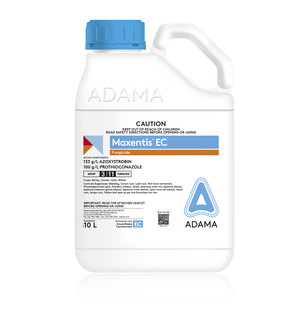
Croppers ready for disease with better fungicide arsenal

HAVING another weapon in the arsenal against crop disease that already is proven in battle provides strong confidence to growers facing another high disease pressure season.
That is how Sam Modra, Agronomist with AW Vater & Co at Saddleworth in South Australia’s Lower North region, views the upcoming season for cereal growers in the local area and the role the recently arrived Maxentis® fungicide can play for them.
Sam, who is in his sixth season supporting growers throughout the region with AW Vater & Co, said wetter conditions last year increased incidences of powdery mildew, rust diseases plus some septoria in wheat crops, suggesting high disease pressures could prevail again this season.
He said there had been heavy use of epoxiconazole fungicide against these diseases through the area, as well as to target eyespot, so it was good to add Maxentis to fungicide programs last year.
Developed by ADAMA Australia, Maxentis is a unique co-formulation of prothioconazole and azoxystrobin that can also be applied in canola and oat crops. It offers more options for controlling disease and managing disease resistance, plus flexible application timing and better crop safety when mixed with other protection and input products.
In addition to targeting powdery mildew, septoria, yellow leaf spot, net blotches, scald and ramularia in cereals, Maxentis controls seedling and upper canopy blackleg and sclerotinia in canola. “It’s definitely good to have a product with two active (ingredients) from two different fungicide groups to help give epoxiconazole a rest,’’ Sam said.
“It’s providing a few more options and the opportunity to use different fungicide mixes.’’ He said last season after epoxiconazole was used first particularly for eyespot, Maxentis was then used mainly on wheat as the second fungicide application.
“Rust took-off and there were patches of powdery mildew and the results with Maxentis were excellent. A lot of fungicides struggle with powdery mildew, but it was very good. You could definitely see on the rust that it makes everything express and shuts down the pustules.
“Once growers got their heads around seeing the rust expressing, it was all good and they were pleased. It’s good to have Maxentis in the arsenal and we finished up having one of the best years in the area. It was also applied in some oats to control red leather leaf (RLL) and did a good job. This was handy, as it is one of the only products registered to control RLL.’’
Sam said at least two fungicide applications through the season was typical for the area, normally at GS31 or slightly earlier to combat the eyespot and then around the flag leaf stage.
He said with the anticipated high rust levels again this season, in wheat-on-wheat situations it could be a good control and resistance management strategy to apply Maxentis as the first application, thereby alternating the fungicide used at that timing.
Similar to last year, it also is expected to be used in tank mixes with broadleaf herbicides, which were successful and demonstrated good product compatibility and crop safety.
Ashley Pilkington, Market Development Manager with ADAMA Australia in SA, also confirmed Maxentis proved to be a great rotation option where epoxiconazole was strongly used previously.
“Earlier trial work in wheat has shown it is particularly effective on powdery mildew. Trials have also shown good activity against spot form and net form of net blotch in barley,’’ Ashley said.
He said the excellent crop safety with Maxentis provided opportunity for good tank mix combinations and, in turn, improved disease control.
